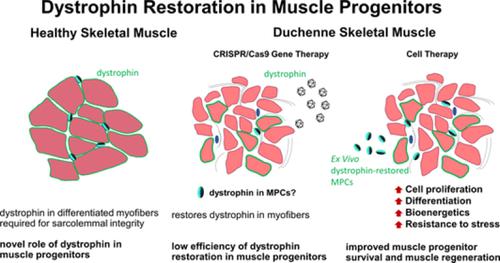当前位置:
X-MOL 学术
›
STEM CELLS
›
论文详情
Our official English website, www.x-mol.net, welcomes your feedback! (Note: you will need to create a separate account there.)
CRISPR/Cas9-based Dystrophin Restoration Reveals a Novel Role for Dystrophin in Bioenergetics and Stress Resistance of Muscle Progenitors
STEM CELLS ( IF 5.2 ) Pub Date : 2019-11-18 , DOI: 10.1002/stem.3094 Polina R Matre 1 , Xiaodong Mu 1, 2 , Jianbo Wu 1, 3 , Delia Danila 4 , Mary A Hall 1 , Mikhail G Kolonin 3 , Radbod Darabi 3 , Johnny Huard 1, 2, 3
STEM CELLS ( IF 5.2 ) Pub Date : 2019-11-18 , DOI: 10.1002/stem.3094 Polina R Matre 1 , Xiaodong Mu 1, 2 , Jianbo Wu 1, 3 , Delia Danila 4 , Mary A Hall 1 , Mikhail G Kolonin 3 , Radbod Darabi 3 , Johnny Huard 1, 2, 3
Affiliation

|
Although the lack of dystrophin expression in muscle myofibers is the central cause of Duchenne muscular dystrophy (DMD), accumulating evidence suggests that DMD may also be a stem cell disease. Recent studies have revealed dystrophin expression in satellite cells and demonstrated that dystrophin deficiency is directly related to abnormalities in satellite cell polarity, asymmetric division, and epigenetic regulation, thus contributing to the manifestation of the DMD phenotype. Although metabolic and mitochondrial dysfunctions have also been associated with the DMD pathophysiology profile, interestingly, the role of dystrophin with respect to stem cells dysfunction has not been elucidated. In the past few years, editing of the gene that encodes dystrophin has emerged as a promising therapeutic approach for DMD, although the effects of dystrophin restoration in stem cells have not been addressed. Herein, we describe our use of a clustered regularly interspaced short palindromic repeats/Cas9‐based system to correct the dystrophin mutation in dystrophic (mdx) muscle progenitor cells (MPCs) and show that the expression of dystrophin significantly improved cellular properties of the mdx MPCs in vitro. Our findings reveal that dystrophin‐restored mdx MPCs demonstrated improvements in cell proliferation, differentiation, bioenergetics, and resistance to oxidative and endoplasmic reticulum stress. Furthermore, our in vivo studies demonstrated improved transplantation efficiency of the corrected MPCs in the muscles of mdx mice. Our results indicate that changes in cellular energetics and stress resistance via dystrophin restoration enhance muscle progenitor cell function, further validating that dystrophin plays a role in stem cell function and demonstrating the potential for new therapeutic approaches for DMD. Stem Cells 2019;37:1615–1628
中文翻译:

基于 CRISPR/Cas9 的肌营养不良蛋白修复揭示了肌营养不良蛋白在生物能量学和肌肉祖细胞的抗压性中的新作用
尽管肌肉肌纤维中缺乏肌营养不良蛋白表达是杜氏肌营养不良症 (DMD) 的核心原因,但越来越多的证据表明 DMD 也可能是一种干细胞疾病。最近的研究揭示了卫星细胞中肌营养不良蛋白的表达,并证明肌营养不良蛋白缺乏与卫星细胞极性、不对称分裂和表观遗传调控的异常直接相关,从而导致 DMD 表型的表现。尽管代谢和线粒体功能障碍也与 DMD 病理生理学特征相关,但有趣的是,肌营养不良蛋白在干细胞功能障碍方面的作用尚未阐明。在过去几年中,编辑编码肌营养不良蛋白的基因已成为 DMD 的一种有前途的治疗方法,尽管尚未解决干细胞中肌营养不良蛋白恢复的影响。在此,我们描述了我们使用成簇的规则间隔短回文重复序列/基于 Cas9 的系统来纠正营养不良 (mdx) 肌肉祖细胞 (MPC) 中的肌营养不良蛋白突变,并表明肌营养不良蛋白的表达显着改善了 mdx MPC 的细胞特性体外。我们的研究结果表明,肌营养不良蛋白恢复的 mdx MPC 显示出细胞增殖、分化、生物能量学以及对氧化和内质网应激的抵抗力的改善。此外,我们的体内研究证明了 mdx 小鼠肌肉中校正 MPC 的移植效率提高。我们的结果表明,通过肌营养不良蛋白恢复,细胞能量学和压力抵抗的变化增强了肌肉祖细胞的功能,进一步验证了肌营养不良蛋白在干细胞功能中的作用,并证明了 DMD 新治疗方法的潜力。干细胞 2019;37:1615–1628
更新日期:2019-11-18
中文翻译:

基于 CRISPR/Cas9 的肌营养不良蛋白修复揭示了肌营养不良蛋白在生物能量学和肌肉祖细胞的抗压性中的新作用
尽管肌肉肌纤维中缺乏肌营养不良蛋白表达是杜氏肌营养不良症 (DMD) 的核心原因,但越来越多的证据表明 DMD 也可能是一种干细胞疾病。最近的研究揭示了卫星细胞中肌营养不良蛋白的表达,并证明肌营养不良蛋白缺乏与卫星细胞极性、不对称分裂和表观遗传调控的异常直接相关,从而导致 DMD 表型的表现。尽管代谢和线粒体功能障碍也与 DMD 病理生理学特征相关,但有趣的是,肌营养不良蛋白在干细胞功能障碍方面的作用尚未阐明。在过去几年中,编辑编码肌营养不良蛋白的基因已成为 DMD 的一种有前途的治疗方法,尽管尚未解决干细胞中肌营养不良蛋白恢复的影响。在此,我们描述了我们使用成簇的规则间隔短回文重复序列/基于 Cas9 的系统来纠正营养不良 (mdx) 肌肉祖细胞 (MPC) 中的肌营养不良蛋白突变,并表明肌营养不良蛋白的表达显着改善了 mdx MPC 的细胞特性体外。我们的研究结果表明,肌营养不良蛋白恢复的 mdx MPC 显示出细胞增殖、分化、生物能量学以及对氧化和内质网应激的抵抗力的改善。此外,我们的体内研究证明了 mdx 小鼠肌肉中校正 MPC 的移植效率提高。我们的结果表明,通过肌营养不良蛋白恢复,细胞能量学和压力抵抗的变化增强了肌肉祖细胞的功能,进一步验证了肌营养不良蛋白在干细胞功能中的作用,并证明了 DMD 新治疗方法的潜力。干细胞 2019;37:1615–1628



























 京公网安备 11010802027423号
京公网安备 11010802027423号